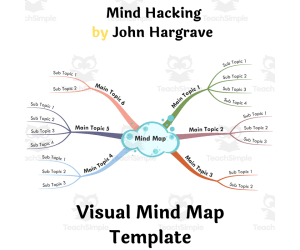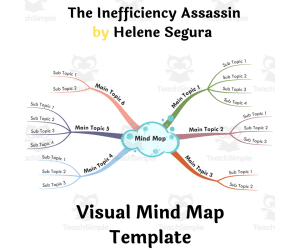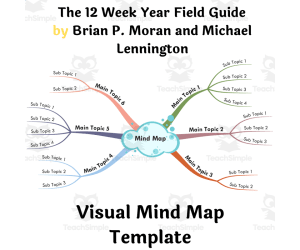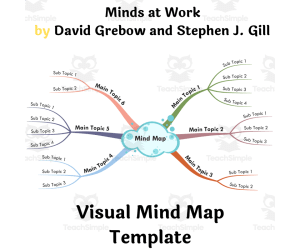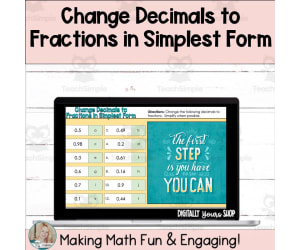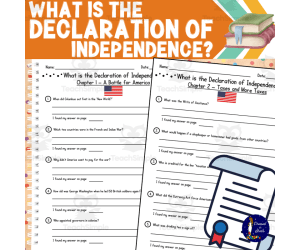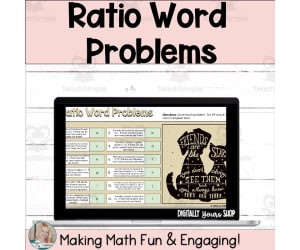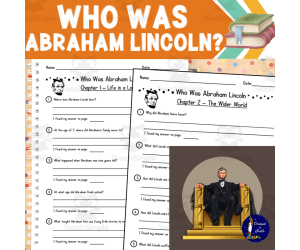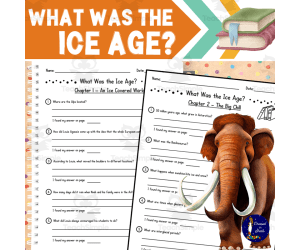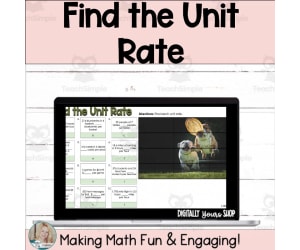6,588 products added recently
Page 734 - Newest Teaching Resources
i-e Decodable Reading Book Level 1: 26
Special Resources, ELA, Special Education Needs (SEN), Language Development, Pre-Reading, Phonics, Reading, Kindergarten, Preschool, Grade 1,
This 26th book in a decodable reading series introduces words with the split digraph i-e. Specially created by an early years specialist teacher to support beginning and struggling readers, it forms part of a structured early phonics reading scheme. With common sight words and decodable words containing digraphs like ck, oo, ee, sh, ch, th, ng, ing, ar, or and a-e, this book tells a simple story through its pictures and text. Used on its own or combined with the matching workbooks , it helps teach phonics skills systematically. Suitable for whole class, small group, or individualized instruction, this book has been tested on diverse readers. Part of a popular series that follows CVC, consonant blends, and common digraphs sets.
Author Lilibette's Resources
Tags I-e, Split Digraph, Decodabel Reading Books, Decodable Reading Books, Phonic Reading Scheme, Download And Print Decodable Readers, Silnt E, Silent E, Magic E, Lazy E
a-e Phonic Worksheets for Special Needs Plus GAME
Special Resources, ELA, Language Development, Phonics, Reading, Spelling, Kindergarten, Preschool, Grade 1, 2, Worksheets & Printables, Worksheets, Activities, Games
This is a pack of 12 Phonic worksheets to teach the split digraph a-e, specially designed for those with special needs, including those with dyslexia or who may be suspected of being dyslexic but will work equally well with young learners in Kindergarten/EYFS/Y1. It includes a phonic 'a-e' game to aid learning. These sheets are LETRS and UK GOV requirements aligned. These worksheets also align with the most popular phonic programmes, including RWI and Letters and Sounds.) Who are these worksheets for? I have written them for pupils who struggle with processing information - especially sounds. This includes children who are DYSLEXIC or have ANY other kind of processing disorder. Such children may have failed with other methods of teaching phonics. Such pupils need activities that: ·are highly structured - one tiny step at a time building on the one before using only a limited number of words to start with and only using words that the child has already learnt to sound out, with no nasty surprises. ·Have only a little on each pageas these pupils tire easily. What makes these worksheets special? I have a powerful three-step process which I use with my special needs pupils, which is worked out over the course of the 12 worksheets: 1. See it!where we focus on becoming aware of the new sound in words. This involves first hearing the new sound in words and then seeing it in words (tracking). 2. Sound-it-out!Having learnt to see the new sound in words, we learn to sound out these words to read and write them. We begin by usingsound-it-out boxesfor reading and spelling which help the child to segment the word prior to blending the sounds together. Once the child can read and write individual words, we work on fluency by building familiarity with the common words in the new sound family. Once the child can sound the words out to read and spell confidently, we move on to recognising them/using them in longer reading and dictation passages, as soon as the child is able. I provide 2 reading passages with comprehension exercises and one dictation passage, with a page in the workbook dedicated to it, with room for a picture, which again cements understanding. 3. Write it! Incorporated into the above two steps, we constantly write the new sound. This adds a multi-sensory dimension to our work - we see with our eyes, we sound it with our mouth parts and voice, and then we move by writing. All three steps work together to help the child feel in control of his/her learning and to become a successful, confident learner. We finish each sound with a dictation which culminates our work before we remove on to the next sound. I try to give this a week after we finish the book, to act as revision. The dictation: Read this passage to your pupil, who should write it. Have the child read his/her work and check for errors. Make sure the writing is completely accurate before saying the child has finished, including full stops and capital letters correctly used. Flashcards are included. What is included in the pack: A front cover 12 Activities based on the 'Sound it out' principles. A dictation Flashcards Phonic a-e Game The Phonic a-e Game helps pupils to decide whether a word needs an 'e' or not. The game helps children to grapple with the new rule in an engaging way while providing the teacher with opportunities for assessment . Full instructions provided. Both in colour and black and white: the black/white version is good to send home for extra practice. MORE Please note: This pack is in a series: Find: EE Phonic Worksheets for Early Years/Intervention AR Phonic Worksheets for Early Years/Intervention OR (In the Lilibette's Resources Store I do hope others find these Special Needs Phonic worksheets helpful for their pupils with ordering and processing difficulties!
Author Lilibette's Resources
Tags Split Digraph A-e, A-e, Phonics A-e, Silent E, Magic E, Phonic Worksheets, Special Needs, Phonic Games, Print N Play Phonic Game, A-e Worksheets
a-e Phonic Game: 'E' or no 'E'? Print 'n Play!
Special Resources, ELA, Special Education Needs (SEN), Language Development, Pre-Reading, Phonics, Reading, Spelling, Kindergarten, Preschool, Grade 1, Activities, Games
Here is a simple, fun, print n' play phonic game to help children learn the split digraph a-e. Your pupils will learn in no time with this easy-to-play game! This is a game for 2 players. The pack included both colour and black and white versions. Laminate the colour version for durability and sen the black and white version home for extra practice. Who can use the a-e phonic Game? Teachers, Parents home-educators Private Tutors Anyone who needs it! Aim of the game: ·To demonstrate how the short vowel sound /a/ changes when ‘e’ is added to make /ae/. ·To give the child plenty of practice recognising the difference between /a/ words and /ae/ words. How to play: Place the picture/word cards in a pile and put the ‘e’ cards neatly on the table. Players take turns to take a spot card from the feely bag. A green spot means that the player should take the topmost picture/word card from the pile and place it in front of him/her. S/he must then decide (by reading the word, sounding out if necessary) whether or not this word requires an ‘e’ or not to change the /a/ to /ae/. If needed the ‘e’ should be added and the card set aside by the player. If not, the word should be placed likewise. Should a red spot be picked, the player must miss a turn. The winner is the player with the most completed cards when al the cards have been used up. Should a player add an ‘e’ when it is not needed, or fail to add one when it is needed should/would/could lose the card, should the teacher deem it helpful to the child. In some cases, the teacher may allow the child help and let the child keep the card once corrected. This is at the teacher's discretion bearing in mind the needs of each child. Teaching tips: This game provides the opportunity for the pupil and teacher to see just where there are problems - listen out for the ‘messages’ in a pupil’s hesitation, his/her misreading of a word so that it does not describe the picture, or thoughtlessness in studying the word and picture carefully to decide about the need, or not, of the ‘e’. These are all indicators of understanding. discipline is required too as the pupil realises that letters in words and spelling are important. For many pupils, this is a new discovery. ‘Look what you have done to ‘hat’! You have changed it into ‘hate’ by putting ‘e’ on the end! This states the problem and for many pupils is the key to sorting out whether an ‘e’ is needed or not. Included: 1 PDF file with 1 game in both colour and black and white.
Author Lilibette's Resources
Tags A-e Game, Split Digraph A-e, Split Dihraph, Silent E, Magic E, Lazy E, Split Digraph, Phonics, Sepcial Needs, Special Neeeds
Mind Hacking- John Hargrave- Book Summary Visual Mind Map (+Template)
Life Studies, Coaching, Business, Career, Adult Education, Not Grade Specific, Diagrams, Teacher Tools
Mind Hacking-John Hargrave- Book Summary Visual Mind Map (+Template) is an instructional apparatus designed for educators' advancement in personal and professional domains. It leverages the teachings of self-help author John Hargrave's book 'Mind Hacking'. Understanding and surmounting mental and emotional struggles such as depression, addiction, etc., finding joy in life's successes by "hacking" thoughts towards empowering beliefs underline this resource's content. The crux of this product lies within its unique use of a visual mind map, a tool mirroring our brain's neural pathways to facilitate ideation, memory retention, making connections and more. Unlike linear note-taking methods that might stymie creativity or impose rigid conceptual structures, a visual mind map invites an unobstructed flow of thoughts - using keywords or phrases, icons or images. Complex subjects are simplistically absorbed via hierarchical linkages between main concepts with their sub-topics visually represented on a 'mind map'. Educators can deploy this versatile tool across learning environments whether during whole group sessions dissecting lessons from 'Mind Hacking', orchestrating small group activities through real-life implementation scenarios based on these principles. It also functions as an individual study guide aiding home assignments—it encourages independent reflection fostering personal insights about unique thought patterns. The Mind Hacking-John Hargrave -Book Summary Visual Mind Map (+Template) comes with PDF files delineating benefits that proficiency over ‘mind mapping’ offers apart from access to two variations of HTML-based classic/right-aligned visual-mind-map. This invaluable pedagogic asset supports adult education particularly within life coaching disciplines such as career planning or business strategies. It’s multi-subject applicability cuts across areas pertaining to personal/professional growth contributing towards intellectual autonomy in students. Whether it's an entrepreneur crafting a dynamic business plan, a project manager sharing ideas with their team or during original content creation, this resource stands to benefit anyone willing to explore the limitless potential of their mind. Note: To best view the elaborate infographics on desktops/laptops via Chrome, Firefox, Safari, Opera or Internet Explorer browsers - zooming into specific branches offers the best results.
Author BookoMap
Tags Mind Hacking, Personal Growth, Mental Well-being, Emotional Well-being, Visual Mind Map
The Inefficiency Assassin by Helene Segura- Visual Mind Map
Life Studies, Coaching, Business, Career, Adult Education, Not Grade Specific, Diagrams, Teacher Tools
◈ The Inefficiency Assassin by Helene Segura- Visual Mind Map (+Template) ◈ The Inefficiency Assassin by Helene Segura is a practical guide to help people overcome procrastination, distractions and other inefficiencies that hinder productivity. This book emphasizes the importance of self-awareness and setting realistic goals to avoid burnout and achieve success. The author offers a variety of tools and strategies to help readers establish effective routines, streamline tasks and ultimately maximize their time and energy. From time-blocking to identifying time-wasters, The Inefficiency Assassin provides actionable tips to transform a disorganized and unproductive schedule into a productive one. By using the insights provided in this book, individuals can learn how to work smarter, not harder, and achieve their goals with less stress and more efficiency. ◈ A Visual Mind Map flows just like our brain does and they are NOT in Nice Neat Lines! A Mind Map enables free flow of ideas because you mostly use short phrases, keywords, images, and icons. You can jot down ideas a lot faster than usual, which results in an unobstructed flow of ideas. ✔✔ WHY MIND MAPS? Mind mapping is a powerful visual tool that allows you to create a hierarchical structure of ideas, concepts, and information. By mapping out the main ideas and subtopics related to a particular subject, you can identify the key areas you need to focus on, and see how they are interrelated. No matter how complex or broad a subject is, a mind map brings order into the chaos and helps you see the 'bigger picture'. This process not only helps you to understand the material better but also aids in recalling the information when needed. Mind mapping can be especially helpful when studying for exams, researching a topic, or planning a project. It can also help you to generate new ideas and connections that you may not have thought of before. Overall, mind mapping is an excellent technique to help you stay organized, focused, and productive amidst the information overload. ✔✔ WHO NEEDS MIND MAPS? Anyone from a student to a CEO can use and benefit from this technique. Here are a few examples. Students:– Preparing for exams and wanting to boost their learning capabilities and results Event Planners:– Wanting to organize every aspect of an event Writers:– Wanting to Create original Content, Stories, Articles, etc. Entrepreneurs:– Wanting to Create a road map or a dynamic Business plan Project Managers:– Wanting to present their ideas clearly to their team Teachers:– Wanting to improve communication in the classroom Marketers:– exploring potential Avenues for promoting a product or service Consultants / Advisors:– trying to visualize Clients Situation Collaborative Teams:– working on a project together Anybody:- Anybody can use mind maps to unleash their creativity, solve problems, visualize their goals, and organize their thoughts! Note: It is recommended that you view the Mind Maps on your Desktop/Laptop. Zoom in on a particular branch for the best view. A Mind Map by Arpit Banjara - I am a 'MindMeister' certified Mind Mapping expert. Get 20% off on your MindMeister, MeisterTask, MeisterNote Subscriptions - Use Promo Code - ARPIT20
Author BookoMap
Tags Bookomap Mindmap, Mindmap Template, Book Summary Mindmap, Mindmaps, Book Review, The Inefficiency Assassin Book Review, Helene Segura's The Inefficiency Assassin, Strategies For Improving Productivity And Efficiency, Empowering Insights On Time Management And Organization, Transforming Your Approach To Work And Productivity, Visual Assassin
A-E Phonic Game Print 'n Play!
Special Resources, ELA, Language Development, Pre-Reading, Phonics, Reading, Spelling, Kindergarten, Grade 1, 2, Activities, Games
Here is a fun, print 'n play phonic game for the split digraph a-e! Help your pupils to grasp the tricky split digraph concept as they play! Who is the a-e game suitable for? All learners of phonics, including young children, SEN/special needs, ESL etc... Aims and Objectives Some children, when starting to learn about the long /a-e/ sound will start to make every /a/ into a long /a-e/ sound. While this is common among all children, some children need more help to overcome this difficulty. Therefore, this game has two aims: 1.To help children to be able to hear the long vowel sound a-e in words 2.To help children understand that some words have a short /a/ and some have a long /a-e/; the child must listen to hear which word has which - not guess. How to play: This is a game for two players. The teacher should watch if two children are playing together. Each player takes a game board which will indicate whether the player should listen for words with a short /a/ sound or a long /a-e/ sound. The selected picture cards are scattered on the table face down. Players take it in turns to choose a picture card. The player says the word and listens to the vowel sound. Is it short /a/, or long /a-e/? If it belongs on the player’s board, it is placed on one of the oblongs. If not, it is returned to the table, face down. The winner is the player who completes his/her board first. Teaching tips: Support children to sound words out/blend them as needed. Help children to hear the vowel sound by emphasizing it and stretching it out. Help the child to do this as well. Have fun - as this eases children over those tricky spots! What is included? 1 PDF with 2 game boards and 20 pictures all in colour and ink saving black and white. See more fun phonic games in the Lilibette's Resources store! Find: AR Game A-E Game Games for initial/final sounds and much MORE!
Author Lilibette's Resources
Tags A-e, Print N Play Phonic Games, Split Digraph, Split Digraph A-e, Phonics, Phonics Games, Special Needs, ESL, Phonics For ESL, Phonics For Special Needs
The 12 Week Year Field Guide by Brian P. Moran- Book Summary Mind Map
Life Studies, Coaching, Business, Career, Adult Education, Not Grade Specific, Diagrams, Teacher Tools
The 12 Week Year Field Guide by Brian P. Moran- Book Summary Mind Map This is an engaging and innovative teaching resource that takes the conventional yearly goal setting approach and transforms it into a 12-week schedule. This method allows for segmenting a long-term goal into more manageable pieces, essentially improving productivity as well as focus. This book places emphasis on: Setting clear objectives Holding oneself accountable Acting consistently to reach your targets. By using The 12 Week Year Field Guide mind map as a tool, users are encouraged to work smarter rather than harder in order to accomplish their objectives. Product Features: Visual mind map feature: Simulates the human brain flow simultaneously supporting multiple ideas thus resulting in fostering creativity even better. Ease of use: The user can easily jot down ideas with keywords and images ensuring unhindered thought progression without compromising on speed. Included in this Package: Bonus Benefits of Mind Mapping (in Pdf File) HTML files of Visual Mind Map Either Classic or Right Aligned which are compatible with most web browsers such as Chrome, Firefox, Safari Opera Internet Explorer etc. The dynamic tool massively benefits various professionals including: students event planners writers brainstorming fresh original content project managers entrepreneurs coaches teachers marketers consultants advisors collaborating teams working together . The 12 Week Year Field Guide ultimately facilitates users' organization skills and aid them navigate through overwhelming information, offering increased control over tasks leading to high productivity outcomes making it suitable for a wide audience including students, CEOs, business personnel and teachers. For optimal results, it's advised to view these mind maps on Desktop/Laptop allowing zoom-in feature enhancing particular sections emphasizing relevance.
Author BookoMap
Tags Goal Setting, Productivity, Accountability, Focus, Organization
The Motivation Myth by Jeff Haden- Book Summary Visual Mind Map
Life Studies, Coaching, Business, Career, Adult Education, Not Grade Specific, Diagrams, Teacher Tools
Motivation Myth by Jeff Haden- Book Summary Visual Mind Map is an essential tool that offers a unique approach to understanding the path to success and goal setting. Visual mind maps are used for increased comprehension and quick generation of ideas, offering an enriched learning experience. Overview Our aim is to illustrate Jeff Haden's views on motivation through this concise book summary, presented in visual format. According to him, motivation occurs after action rather than before it - this notion has been effectively demonstrated using images, icons and keywords. Inclusions An easy-to-understand synopsis of 'The Motivation Myth' Two versions of HTML formatted mind-maps: Classic Mind Map & Right Aligned Mind Map Mind Mapping Benefits guide A downloadable Template Link as a PDF file. Purpose and Usage The hierarchical structure used in these maps facilitates recall and aids understanding complex information better by dividing them into key topics or sub-points. This way one can comprehend their context more thoroughly - helping students with exam preparation or research related processes. The use-case of our resources isn't confined to education alone but extends up to professional circumstances too: An event planner organizing every detail; The Motivation Myth by Jeff Haden- Book Summary Visual Mind Map can also be utilized as: A novel study guide or activity planner; Furthermore, it's designed for optimal viewing capabilities from a Desktop/Laptop - ensuring an enhanced learning experience. Fields Of Application And Subjects Available As Resources Include: Coaching Business Career building and Other Life Studies for Adult Education etc. The resources mentioned above can be integrated into a curriculum by teachers, or assigned as homework to provide students with an innovative study methodology. In conclusion, the Motivation Myth by Jeff Haden - Book Summary Visual Mind Map' enriches existing materials used for learning and should be considered for addition.
Author BookoMap
Tags Motivation Myth, Goal-setting, Success Mindset, Learning Tool, Educational Resource
Minds at Work By David Grebow and Stephen J. Gill- Visual Mind Map
Life Studies, Coaching, Business, Career, Adult Education, Not Grade Specific, Diagrams, Teacher Tools
Visual Mind Map by David Grebow and Stephen J. Gill Minds at Work - An innovative teaching resource changing the perspective on work in our rapidly evolving technology-driven world. About The Resource Written by David Grebow and Stephen J. Gill, the original book deepens into the influence of technology in reshaping today's workplace while this adapted visual mind map makes these theories accessible. Note: Unlike traditional learning resources, this product does not offer a checklist approach but instead examines how every aspect of work has transformed due to technological advances. Main Features The Visual Mind Map format-This mirrors natural thought processes rather than linear paradigms; Encourages free streams of idea generation via absence-free phrases along with keywords or images for unimpeded flow of thoughts. Diverse Application-A capacity ideal not only as a whole group instruction tool but also effectively used in small groups or even assigned as homework too. Potential benefits include - Improved organization skills amid information deluge and simplifying complex subjects for better understanding. Suitability for varied needs across curriculum requirements include:- Linking study topics, Developing creative projects, Steering strategic planning sessions like CEOs do. Note: We recommend viewing this resource via Desktop/Laptop modes for effortless comprehension. Please note: This valuable compilation includes a PDF outlining benefits if mind mapping, Template Link download file (availability from which users may also stumble across this Visual Mind Map) , swollen with two exclusive editions of the highly comprehensive visual mind map as HTML files. Keep it in your teaching kit. Why And How To Use This? Ideal for: Preparing students for assessments, Assisting them charter their career pathway or even just discussing life skill essentials. Versatility: its informative nature and adaptability makes it apt regardless of grade specifics. A truly valuable asset!
Author BookoMap
Tags Technology-driven World, Workplace Transformation, Adaptable Approaches, Visual Mind Map, Future Skills
Eat That Frog by Brian Tracy- Visual Mind Map (+Template)
Life Studies, Coaching, Business, Career, Early Learning, Pre-K, Not Grade Specific, Diagrams, Teacher Tools
Eat That Frog by Brian Tracy- Visual Mind Map (+Template) An interactive teaching resource designed to enhance students' understanding of productivity and time management principles, as presented in Brian Tracy's renowned self-help book, Eat That Frog. Adapted for learners at different academic stages and for courses like Life Studies, Business Studies, or Career Coaching. Core Concept The key idea is that dealing with the most challenging tasks early in the day can lead to improved productivity and efficiency. This mind map allows exploration through hands-on learning experiences replacing standard textbook summaries or lengthy lectures. Components Included Critical points from the book Benefits of Mind Mapping (PDF File) A Template Link Download file (PDF File) Classic Mind Map and Right Aligned Mind Map (HTML files). Suitable for various web browsers including Google Chrome / Mozilla Firefox / Safari / Opera / Internet Explorer ...etc., it presents an intuitive platform allowing users to draft their ideas in a manner similar to brain data processing; beyond traditional linear note-taking methods. Diverse Application Approaches > Apart from summarizing key ideas from Brian Tracy's book; educators can utilize this resource mutually during whole group sessions as study guides/reference materials or within small groups focusing on individual segments further refining cognitive skills through brainstorming exercises. Also useful beyond classroom settings such as event planners intending to organize facets surrounding an event methodically or marketers probing potential avenues for promoting products/services. For optimal use, view the Mind Maps from Desktop/Laptop. Zoom into a particular branch for the best view. Regarded as 'an unstoppable fusion of learning efficiency', this tool optimizes visualization depicting thought progression offering a creative space for learners/improvers of productivity practices.
Author BookoMap
Tags Productivity, Time Management, Self-help, Mind Mapping, Learning Tool, Eat Visual
The 5 AM Club by Robin Sharma- Visual Mind Map (+Template)
Life Studies, Coaching, Business, Career, Early Learning, Pre-K, Not Grade Specific, Diagrams, Teacher Tools
The 5 AM Club by Robin Sharma- Visual Mind Map (+Template) This is a revolutionary teaching tool aimed at enhancing potential and productivity among students of all levels. It incorporates the principles of Robin Sharma's renowned book, The 5 AM Club, transforming them into an interactive mind map form applicable in whole group learning, small group discussions or as homework tasks. Philosophy & Emphasis: A firm belief in rising early at 5 am to amplify productivity through exercise, meditation and studying. Promotion of self-improvement strategies leading to mastery over life's trajectory. An added advantage lies in its visual design. Converting thoughts into connected paths simplifies an array of complex subjects or exam preparations for students. All-in-one Package: PDF documents explaining the Benefits of Mind Mapping; A Template Link Download file directing you to this beneficial Visual Mind Map; HTML versions (Classic Mind Map and Right Aligned Mind Map) aligning with curriculum needs best. s In a digital era overwhelmed with information surplus, The 5 AM Club by Robin Sharma- Visual Mind Map (+Template) can be an outstanding source for teachers optimizing classroom communication; authors creating original content; entrepreneurs building dynamic business plans. Essentially anyone who needs innovative problem-solving schemes should use it - from ambitious students aiming for academic glory right up to CEOs devising corporate strategies. Note: Optimum results will be achieved when viewed on desktop/laptop displays due to screen dimensions. But worry not! This versatile resource accessibility extends across all web browsers – Google Chrome, Mozilla Firefox, Safari and even Internet Explorer. Hence making this resource a formidable must-have teaching tool.
Author BookoMap
Tags Productivity, Self-improvement, Mind Mapping, Robin Sharma, Teaching Resource
My Morning Routine by Benjamin Spall and Michael Xander- Mind Map
Life Studies, Coaching, Business, Career, Adult Education, Not Grade Specific, Diagrams, Teacher Tools
<h3>My Morning Routine by Benjamin Spall and Michael Xander</h3> <p>This is a thoughtful teaching companion equipped with a unique <b><i>Visual Mind Map </i></b>. The resource presents the fascinating insights from success-minded individuals. It emphasizes how their morning habits set the course for their day, be it meditation, journaling, physical exercise or creative pursuits.</p> <p style="text-indent: 50px;"><b style="color:blue;">Goal:</b> To help educators teach students about productivity optimization. It emphasizes individuality in habits and routines, augments creativity and cultivates purpose in daily life. </p> <br>→← The core of this resource lies in its Mind Map ; a tool simplifying complex ideas. The sectors that can benefit from mind mapping: Students preaparing for exams Motivated writers Event planners Entrepreneurs strategizing business plans -and more! Package contains: 'Benefits of Mind Mapping' PDF File 'Template Link Download' file MInd Map —-> 'Visual Mind Map ' HTML files - 2 Variations – ClassicMindMap/RAlignedMindMap viewable through web browsers.(i.e., Google Chrome/Mozilla Firefox/Safari/Opera/Internet Explorer) <p>Use My Morning Routine's mind map approach in whole group discussions or small group settings, even as a homework assignment. It is suitable for Adult Education and applicable to varied subjects like life studies, business, career alongside coaching classes.</p> <p style="font-size:16px;"><font color="green">This tool is a must-have for the modern-day educator! Available in multiple file types for easy download and usage.</font></p>
Author BookoMap
Tags Morning Routines, Productivity Optimization, Mind Mapping, Habits, Success-minded Individuals
Dot a Dot | Points on a Coordinate Plane 6th Grade End of Year
Math, Graphing, Grade 5, 6, 7, Activities
Product Title: Dot a Dot | Points on a Coordinate Plane 6th Grade End of Year The Dot a Dot activity is an interactive and entertaining way for your 6th graders to review coordinates. This dynamic learning tool covers all four quadrants of the coordinate plane, reinforcing critical mathematical concepts while maintaining student engagement. Ideal for instructors searching for innovative additions to their lesson plans or parents seeking educational undertakings, this activity serves well in both school and home environments. Distinctive Attributes: Digital format easily tailors to diverse teaching methods. Demand minimal preparation—provide the link and let students plunge into learning. Digital convenience proves advantageous in remote instruction circumstances. No need for Google Classroom or Microsoft Teams logins ensures smooth execution with no compatibility issues. Versatility: The activity can be utilized across various situations such as: Early finishers, End-of-the-year tasks, Back-to-school duties, or As part of your staple math syllabus. If math-related topics are on your agenda for review sessions that your learners will enjoy and gain value from—here's the perfect tool! Note:- Minimal instructor input is required save providing access via link while versatility optimizes its usage—an ideal online venture that lends itself equally accommodating within any 6th-grade classroom setup or homeschooling setup alike. Specs: Subjects: Math Subsubjects: Graphing Types: Activities Grade Levels: Grades 5, 6, and 7. Password Protected PDF with Links: Digital (PDF with the link to the activity ) - Common Core Standards: : CCSS6.G.A.3 - File Type: PDF format The Dot a Dot activity makes math learning an engaging escapade while seamlessly blending with your instructional workflow. Don't miss the chance—Set your students on a math journey worth remembering today!
Author Matemaths
Tags Coordinate Plane, Graphing, Interactive Activity, Math Review, Self-checking
Cupcakes Clip Art
, Not Grade Specific,
Cupcakes Clip Art is perfect for any of your classroom decorations. The vibrant colors are perfect for birthday parties, calendars, or the like. This Cupcakes Clip Art resource was designed for elementary school classrooms, though this can be used in any classroom wishing to decorate in a fun way! These images add a tangible sense of artistic exploration to the learning environment. This Cupcakes Clip Art resource is delivered in a user-friendly digital format, they provide teachers the convenience to incorporate them across various platforms and materials. This Cupcakes Clip Art resource includes - 7 cupcakes in color and - 7 in black and white. - All 14 PNG's of Cupcakes Clip Art come in a ZIP file. You can print and distribute these Cupcakes Clip Art among your students to color, and then arrange on the bulletin board. You can also print, color, and laminate two sets of and make it a game ! Credit not required but appreciated. :) May you have the best of fun creating using this Cupcakes Clip Art resource! For similar or other engaging resources for your students, visit my store here!
Author Soumara Siddiqui
Tags Cupcakes Clip Art, Cupcakes
Printable Cupcakes
Creative Arts, Art, Graphic Arts, Grade 3, 4, 5, Worksheets, Worksheets & Printables
Printable Cupcakes: An Exceptional Teaching Resource A great tool for public school educators and homeschooling parents alike, the Printable Cupcakes are versatile, print-ready materials that offer a refreshing alternative to traditional classroom resources. Full of creativity and color, the Printable Cupcake project provides a host of opportunities for classroom use. Whether enhancing group tasks or individual projects such as creative writing or art assignments, these resources can improve student experiences significantly. What's Included The product contains 36 pages in one PDF file. Six unique cupcake designs are included in two sizes - full-page cupcakes and medium-sized cupcakes which allow two prints per page. Each design is available with and without lines to accommodate various intended uses – as attention-grabbing decorations or canvases for capturing student information. The possibilities are endless: Your bulletin boards could pop with vibrantly colored cupcakes by your students! Create lasting learning materials due to their reusable nature – print, cut out shapes & laminate them to create write-on/wipe-off surfaces perfect for practice exercises using dry-erase markers! You can even make an attractive birthday bulletin board featuring each student's birth details uniquely displayed on a cupcake design of their preference! This certainly adds an element of fun into everyday learning. This resource mainly targets Grade 3-5 learners studying Art & Music subjects such as Coloring or Graphic Arts but represents a fun addition that transcends conventional teaching structures. Note: The ideas provided here remain only generic suggestions. We encourage teachers to discuss further how this versatile product could be used most effectively within related course structures & curricula within their professional teaching circles.
Author Soumara Siddiqui
Tags Classroom Décor, Bulletin Board, Creative Writing, Art And Music, Reusable
Change Decimals to Fractions in Simplest Form Digital Self-Checking
Math, Decimals, Fractions, Grade 6, Activities
Change Decimals to Fractions in Simplest Form Digital Self-Checking: An Interactive Learning Tool for Mathematics A revolutionary hands-on tool: This enhancement tool is designed to provide learners with a fun and interactive way of learning decimals and fractions. Core Features: Total of twelve problems demonstrating the changes from decimals into fractions in simplest form. Designed meticulously for Google Sheets, ensuring ease of use and student engagement. Innovative Scramble Picture Reveal Activity : This self-assessing teaching resource offers an engaging exercise where solutions reveal an obscured image gradually, dependent on students' accuracy. It seamlessly integrates assessment while keeping it entertaining. Self-checking Functionality: The insertion of final answers reveals immediate color-indicated feedback. Correct answers turn green revealing sections of a hidden picture, while incorrect ones turn red leaving the image unaltered. This system promotes competition helps motivate students by piquing their curiosity. Morning lessons or homework sessions Bell ringer activities or exit tickets Inclusion in Math warm-ups reteaching/reviewing procedures An Added Convenience: Teacher Answer Key- The built-in Teacher Answer Key simplifies evaluations thereby saving valuable time - a significant reason why every teaching toolkit should include this! Specially Designed For 6th Grade Learners: Emphasizing primarily on Decimals & Fractions Subsubjects, this digital self-checker boasts maximum useability with minimal preparatory work!
Author Digitally Yours Shop
Tags Decimals, Fractions, Interactive Learning, Self-checking Assessment, Engaging Activities
What Was the Berlin Wall? by Nico Medina Questions
ELA, Reading, Reading Comprehension, Writing, Grade 5, 6, Worksheets & Printables, Novel Studies, Activities
What Was the Berlin Wall? Comprehension Questions Engage students while reading What Was the Berlin Wall? by Nico Medina with these reading comprehension questions. Provides 5 thoughtful questions per chapter to encourage close reading, critical thinking, and rich discussion. Suitable for independent reading, small groups, or whole class novel studies . Students answer questions in complete sentences, citing text evidence. Promotes attention to detail, comprehension, and quality dialogue. Implementation ideas included. 42 total questions covering all chapters with answer key. Useful for grades 5-6 language arts. Check out the thumbnails to see how this novel study guide can spur learning.
Author Soumara Siddiqui
Tags What Was The Berlin Wall? By Nico Medina Questions, Book Questions
What Was the Great Depression? by Janet B Pascal Questions
ELA, Reading, Reading Comprehension, Writing, Handwriting, Grade 5, 6, Teacher Tools, Lesson Plans, Assessments, Activities
What Was the Great Depression? Discussion Questions This supplemental reading guide encourages critical thinking and comprehension for the nonfiction history book What Was the Great Depression? by Janet B. Pascal. With 5 discussion questions per chapter, students will analyze the struggles of people living through the Great Depression era. The open-ended questions prompt students to find textual evidence, think critically about the content, and have meaningful discussions. This resource works well for independent reading, literature circles, or homeschooling. With no questions relating to previous chapters, students can begin answering from any section of the book. An answer key is included. Engaging with these insightful questions will lead to a deeper understanding of the book, the period in history, and the resilience of people.
Author Soumara Siddiqui
Tags What Was The Great Depression? By Janet B Pascal Questions, Book Questions
What Is the Declaration of Independence by Michael C Harris Questions
ELA, Reading, Reading Comprehension, Writing, Grade 5, 6, Teacher Tools, Assessments
What Is the Declaration of Independence? by Michael C Harris Questions These questions were designed to encourage engagement and attention to details while reading. Produce higher quality talks as the students answer the questions regarding the book and the struggles of the people therein. Each chapter will have 5 questions to be answered. Students are encouraged to answer the questions in complete sentences and write the number of the page in which they found their answer. Each question is written in a way in which students will draw the answers from the text to make sure they are reading the book and understanding what they are reading. This resource is great for students reading alone or with a parent. It will produce fruitful conversations as you end each chapter. All chapter questions can be started from any chapter since the questions do not include questions about previous chapters read. This resource thrives due to close reading and thoughtful, critical analysis of chapters, and their information. Includes 5 questions for all chapters (chapter 1 to chapter 9) regarding the book: What Is the Declaration of Independence? by Michael C Harris Answer key is included. Check out the thumbnails to see how this resource can make a great reading companion. Have fun reading & chatting!
Author Soumara Siddiqui
Tags What Is The Declaration Of Independence By Michael C Harris Questions, Book Questions
What Was the Alamo? by Pam Pollack and Meg Belviso Questions
ELA, Reading, Reading Comprehension, Writing, Handwriting, Grade 5, 6, Teacher Tools, Assessments
Title: What Was the Alamo? by Pam Pollack and Meg Belviso Questions A Comprehensive Teaching Resource for Enhancing Comprehension and Engagement Overview: This is an 18-page teaching resource, a PDF file supplementing the book What Was the Alamo? by Pam Pollack and Meg Belviso. It is strategically designed for grade 5 and 6 language arts educators focusing on enhancing comprehension, reading, and handwriting skills of students. Carefully Crafted Questions: The resource contains each chapter's astute questions requiring students' detailed attention but not deeper literary analysis or plot predictions. Enhanced Classroom Discussions: The questions can be assigned as homework or used during small group discussions to promote quality classroom conversations about each chapter content. No Overlapping Questions: This feature ensures that educators can start from any chapter without losing context or continuity—an ideal for staggered reading schedules or late-joining students. Bonus Feature: Answer Key Lowers Assessment Challenge for Instructors : Makes home-based education more manageable due to simplified assessment procedures with a provided answer key. Empowered Educators Webinar Series - US-KBCTN.pptx (Slide 8) Conclusion:In essence, consider “What Was The Alamo? by Pam Pollack and Meg Belviso Questions” as your all-in-one teaching companion when navigating this captivating historical tale with your class! It fosters engaging learning dialogues whether used as a standalone guided reading assignment or part of larger group discussions.
Author Soumara Siddiqui
Tags Alamo, Texas History, Comprehension Questions, Reading Engagement, Close Examination
Ratio Word Problems Digital Self-Checking Activity
Math, Algebra, Grade 6, 7, Worksheets & Printables, Word Problems, Activities
Introduction to Ratio Word Problems Digital Self-Checking Activity Ratio Word Problems Digital Self-Checking Activity is an ingenious teaching tool designed to make math lessons a fun-filled experience. This digital resource provides a practical, hands-on approach for educators aiming to clarify the concept of working with ratios while being easily accessible for public school teachers and homeschoolers alike. Suitable Grade Levels and Utility This resource fits perfectly in the curriculum of Grade 6 and Grade 7, particularly focusing on Algebra. While it excellently handles word problems related to ratios, this activity can also be molded for an array of other mathematical concepts. Description of the Activity The learning experience gets amplified with this engaging activity featuring a 12-question challenge. As students correctly solve each question on Google Sheets, a hidden image cleverly reveals itself bit by bit, creating an interactive sense of progress. Moreover, color-coded answers add another layer of interactivity: correct responses turn bright green, while incorrect ones appear red. Tailor-made for Different Settings: Implement it during morning tasks or homework; Utilize as bell-ringer tasks or exit tickets; Use it during warm-ups or review sessions—flexibility being its key highlight! Paperless Consistency: The promise is kept simple and adaptive—it requires no time-consuming prep from your end but can be assigned instantly via Google Classroom after adding it to your Google Drive! A Mix of Procedural Knowledge and Conceptual Understanding: The objective here isn't merely about understanding procedures but gaining complete command over conceptual clarity—methodical tools get seamlessly married with fundamental comprehension in this activity. Inclusions Inside: A pack of twelve Ratio Word Problems waits on Google Sheets! There's also a Student Recording Sheet attached to keep track of progress and a Teacher Answer Key to streamline the correction process. The Bottom Line: In conclusion, Ratio Word Problems Digital Self Checking Activity is an undeniably enriching educational asset for all educators advocating holistic learning!
Author Digitally Yours Shop
Tags Ratio Word Problems, Digital Activity, Self-checking, Math Education, Hands-on Learning
Who Was Abraham Lincoln? by Janet B Pascal Questions
ELA, Strategies, Reading, Writing, Handwriting, Grade 4, 5, 6, Activities
Who Was Abraham Lincoln? by Janet B Pascal Questions promote inquisitiveness and attention to detail, transforming an ordinary reading experience into a thorough examination of text. Crafted with purpose, each question helps students delve deeper into the book's content while enhancing both their comprehension and critical thinking skills. This resource is designed around the engaging biography, Who Was Abraham Lincoln? by Janet B Pascal. For all nine chapters of this enlightening and educative book, five questions have been prepared. These questions are specifically structured to incite thoughtful responses from students while simultaneously motivating them to locate the answers within the text itself - a prime strategy that encourages more profound engagement with their reading. Fabricated around students' need to provide answers in complete sentences along with page numbers they found essential information on - a valuable practice for developing preparatory research skills. A relative ease accompanies commencing any chapter without referencing previous ones given these inquiries do not require sequential follow-up from prior chapters read.- guaranteeing flexibility for use in small group discussions or as individual homework assignments–but also serving well for whole class activities. Homeschooling experiences can be enriched using 'Who Was Abraham Lincoln?' by Janet B Pascal Questions – as it generates productive dialogues after every chapter's end–enabling parents to better guide their children through each lesson offered by these detailed conversations evolved around proficiency in Language Arts. A quietly triumphant resource thanks to its concentration on close reading paired alongside thoughtful analysis of each story component;an answer key is provided eliminating guesswork thereby adding value beyond simple comprehension tasks. This 20-page PDF encompasses everything teachers need for cultivating intriguing conversations surrounding one of America's influential figures during Language Arts sessions geared towards grades 4-6 and stands as an equally valuable resource for improving vital skills such as Reading and Handwriting. This is your tool to turn routine reading into an engrossing learning journey.
Author Soumara Siddiqui
Tags Abraham Lincoln, Biography, Reading Comprehension, Critical Thinking, Close Reading
What Was the Ice Age by Nico Medina Questions
ELA, Reading, Reading Comprehension, Writing, Handwriting, Grade 4, 5, 6, Activities
Overview What Was the Ice Age by Nico Medina Questions is an impressive educational resource, curated for teachers instructing Grade 4 to Grade 6 Language Art classes. It emphasizes critical comprehension and reading skills with an aspect of handwriting practice. Purpose This tool serves in enhancing engagement, attention to minute text details, and fostering open discussions among students. About the Tool The toolkit consists of questions explicitly developed for each chapter of the book 'What Was the Ice Age' by Nico Medina. Five unique questions are composed for each chapter designed to integrate clear answers from within the text. A significant feature is that any set of chapter questions can be started from any sequence as they do not intersect or rely on information in preceding chapters. The power within this resources lies mainly in encouraging close reading practices that harness deep and thoughtful insights about various chapters’ context. Suitable Scenarios: In-house schooling involving all class participants, Smaller-focused groups, One-on-one tutoring sessions, Note:what's more, it can even serve as homework assignments providing continuous after-school learning. In House benefits: Note: This tool also proves helpful during independent student study or collaborative work with parents at home stirring meaningful conversations around each completed chapter. Each group comprising five inquiries per chapter impels students to provide answers in complete sentences emphasizing effective writing skills at the same time honing their attention on detail-oriented reading practices. It also insists on jotting down page numbers locating their text snippets inculcating research habits in young learners. An answer key is included within these PDF files, invaluable during educators' assignment tasks checking while students possess a verified source endorsing their concluded derivations, making it an ideal reading complement enriching both teachers' and learners' experiences. Conclusion: Allocate your curious minds to productive discussions concluding every day's lesson with thoughtful question/answer sessions directed towards cohesively absorbing knowledge about our planet's Ice age era through literary exploration aided by our teaching tool - What Was the Ice Age by Nico Medina Questions.
Author Soumara Siddiqui
Tags Ice Age, Comprehension, Reading Skills, Critical Thinking, Writing Practice
Find Unit Rate Self-Checking Digital Activity
, Grade 6, 7, Lesson Plans, Teacher Tools
Find Unit Rate Self-Checking Digital Activity Introducing the Find Unit Rate Self-Checking Digital Activity . This interactive teaching resource incorporates a scramble picture reveal approach that captivates students while they practice working with rates. Key Features: Self-Checking Characteristics: Embedded within Google Sheets, this feature provides immediate feedback to learners - a green indicator signals accurate answers and reveals part of the mystery image in the scramble picture activity . Purposeful Problems: This resource comprises twelve problems that require solutions calculated on whiteboards or scratch paper. Incorrect answers prompt a red indicator, signaling students to work further. Included Materials:: Student recording sheets for procedural transparency and teacher answer key are included - facilitating effective learning practices and saving prep-time respectively. Diverse Applications: This dynamic digital activity has flexible applications beneficial across multiple settings such as; Morning work tasks Homework assignments Bell ringers for initial class engagement ' & Exit tickets post-lessons for evaluating conceptual understanding This no-prep teaching resource accommodates both at-home learning scenarios (ideal for homeschoolers) and classroom situations alike – enabling seamless math review exercises regardless of student location. In conclusion:. The Find Unit Rate Self-Checking Digital Activity efficiently steers procedural comprehension alongside building robust conceptual understanding. It encourages understanding “why” those answers apply – nurturing informed math wizzes ready to scale new heights in the subject.
Author Digitally Yours Shop
Tags Unit Rate, Self-checking, Digital Activity, Scramble Picture Reveal, Immediate Feedback





